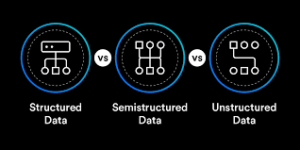Understanding the differences between structured, semi-structured, and unstructured data is essential in data engineering, data analysis, and database management. Each type of data has distinct characteristics, formats, and storage methods, influencing how it is processed and analyzed. Here’s a detailed overview of each type:

1. Structured Data
Definition: Structured data refers to highly organized information that adheres to a predefined schema or format. It is easily searchable and can be stored in traditional relational databases.
Characteristics:
- Fixed Schema: Structured data is organized in rows and columns, where each column has a specific data type (e.g., integer, string, date).
- Data Types: Common data types include integers, floats, strings, and dates.
- Ease of Access: It can be easily queried using SQL (Structured Query Language).
Examples:
- Relational Databases: Tables in SQL databases (e.g., MySQL, PostgreSQL, Oracle).
- Spreadsheets: Data organized in Excel sheets or CSV files.
- Transaction Records: Customer orders, inventory data, and employee records.
Use Cases:
- Ideal for transactional data, reporting, and business analytics where predefined queries are required.
2. Semi-Structured Data
Definition: Semi-structured data does not conform to a rigid schema but still contains some organizational properties that make it easier to analyze than unstructured data. It often uses tags or markers to separate data elements.
Characteristics:
- Flexible Schema: While it has some structure (like tags), it can vary in format and structure from one record to another.
- Hierarchical or Key-Value Pairs: Often represented in formats like JSON, XML, or YAML, which allow nested data structures.
- Self-describing: The data itself contains metadata to help interpret the structure.
Examples:
- JSON Documents: Data exchange format used in APIs and web services (e.g., user profiles, product catalogs).
- XML Files: Markup language used for data representation (e.g., configuration files, web services).
- NoSQL Databases: Databases like MongoDB and Cassandra that store data in flexible formats.
Use Cases:
- Useful for data integration, data interchange, and applications where the data structure may change over time, such as web applications and APIs.
3. Unstructured Data
Definition: Unstructured data is information that does not have a predefined format or organization. It is typically more challenging to process and analyze due to its lack of structure.
Characteristics:
- No Fixed Schema: Unstructured data can vary significantly and does not follow any specific schema or organization.
- Diverse Formats: It can exist in various forms, including text, images, videos, audio files, and social media posts.
- Complex Analysis: Requires advanced analytics techniques (like natural language processing or machine learning) to extract meaningful insights.
Examples:
- Text Documents: Emails, articles, reports, and social media content.
- Media Files: Images, videos, and audio recordings.
- Web Content: HTML pages, blogs, and user-generated content.
Use Cases:
- Ideal for sentiment analysis, image recognition, and other scenarios where rich data sources can provide insights but do not have a predefined format.
Comparison Table
| Feature | Structured Data | Semi-Structured Data | Unstructured Data |
|---|---|---|---|
| Schema | Fixed and predefined | Flexible and variable | No predefined schema |
| Format | Tabular (rows/columns) | Hierarchical (JSON, XML) | Free-form (text, images) |
| Storage | Relational databases | NoSQL databases, files | File systems, object stores |
| Query Language | SQL | Various query methods | Requires complex processing |
| Examples | SQL databases, spreadsheets | JSON, XML, NoSQL data | Text documents, multimedia |
Conclusion
Understanding the differences between structured, semi-structured, and unstructured data is crucial for data management and analytics. Each type requires different processing techniques and tools, influencing how organizations capture, store, and analyze data. By leveraging the appropriate data types, businesses can derive meaningful insights and make informed decisions based on their data landscape.
